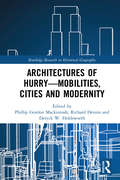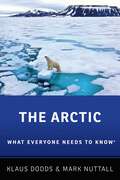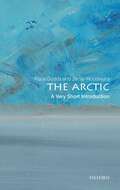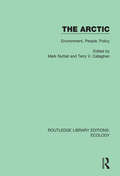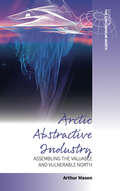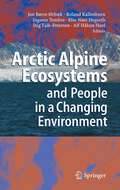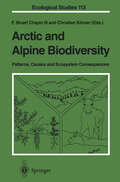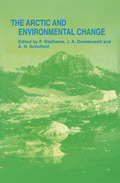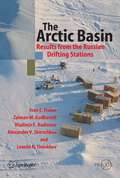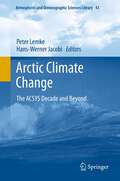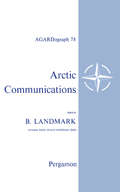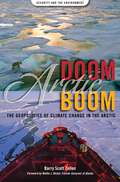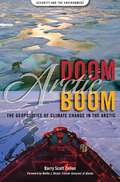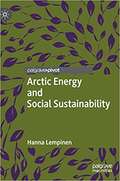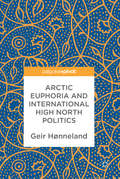- Table View
- List View
The Architecture of Waste: Design for a Circular Economy
by Caroline O'Donnell Dillon PrangerGlobal material crises are imminent. In the very near future, recycling will no longer be a choice made by those concerned about the environment, but a necessity for all. This means a paradigm shift in domestic behavior, manufacturing, construction, and design is inevitable. The Architecture of Waste provides a hopeful outlook through examining current recycling practices, rethinking initial manufacturing techniques, and proposing design solutions for second lives of material-objects. The book touches on a variety of inescapable issues beyond our global waste crisis including cultural psyches, politics, economics, manufacturing, marketing, and material science. A series of crucial perspectives from experts cover these topics and frames the research by providing a past, present, and future look at how we got here and where we go next: the historical, the material, and the design. Twelve design proposals look beyond the simple application of recycled and waste materials in architecture—an admirable endeavor but one that does not engage the urgent reality of a circular economy—by aiming to transform familiar, yet flawed, material-objects into closed-loop resources. Complete with over 150 color images and written for both professionals and students, The Architecture of Waste is a necessary reference for rethinking the traditional role of the architect and challenging the discipline to address urgent material issues within the larger design process.
Architectures of Care: From the Intimate to the Common
by Brittany UttingDrawing from a diverse range of interdisciplinary voices, this book explores how spaces of care shape our affective, material, and social forms, from the most intimate scale of the body to our planetary commons.Typical definitions of care center around the maintenance of a livable life, encompassing everything from shelter and welfare to health and safety. Architecture plays a fundamental role in these definitions, inscribed in institutional archetypes such as the home, the hospital, the school, and the nursery. However, these spaces often structure modes of care that prescribe gender roles, bodily norms, and labor practices. How can architecture instead engage with an expanded definition of care that questions such roles and norms, producing more hybrid entanglements between our bodies, our collective lives, and our environments? Chapters in this book explore issues ranging from disabled domesticities and nursing, unbuilding whiteness in the built environment, practices and pedagogies of environmental care, and the solidarity networks within ‘The Cloud’. Case studies include Floating University Berlin, commoning initiatives by the Black Panther party, and hospitals for the United Mine Workers of America, among many other sites and scales of care.Exploring architecture through the lenses of gender studies, labor theory, environmental justice, and the medical humanities, this book will engage students and academics from a wide range of disciplines.
Architectures of Care: From the Intimate to the Common
Drawing from a diverse range of interdisciplinary voices, this book explores how spaces of care shape our affective, material, and social forms, from the most intimate scale of the body to our planetary commons.Typical definitions of care center around the maintenance of a livable life, encompassing everything from shelter and welfare to health and safety. Architecture plays a fundamental role in these definitions, inscribed in institutional archetypes such as the home, the hospital, the school, and the nursery. However, these spaces often structure modes of care that prescribe gender roles, bodily norms, and labor practices. How can architecture instead engage with an expanded definition of care that questions such roles and norms, producing more hybrid entanglements between our bodies, our collective lives, and our environments? Chapters in this book explore issues ranging from disabled domesticities and nursing, unbuilding whiteness in the built environment, practices and pedagogies of environmental care, and the solidarity networks within ‘The Cloud’. Case studies include Floating University Berlin, commoning initiatives by the Black Panther party, and hospitals for the United Mine Workers of America, among many other sites and scales of care.Exploring architecture through the lenses of gender studies, labor theory, environmental justice, and the medical humanities, this book will engage students and academics from a wide range of disciplines.
Architectures of Hurry—Mobilities, Cities and Modernity (Routledge Research in Historical Geography)
by Phillip Gordon Mackintosh Richard Dennis Deryck W. Holdsworth‘Hurry’ is an intrinsic component of modernity. It exists not only in tandem with modern constructions of mobility, speed, rhythm, and time–space compression, but also with infrastructures, technologies, practices, and emotions associated with the experience of the ‘mobilizing modern’. ‘Hurry’ is not simply speed. It may result in congestion, slowing-down, or inaction in the face of over-stimulus. Speeding-up is often competitive: faster traffic on better roads made it harder for pedestrians to cross, or for horse-drawn vehicles and cyclists to share the carriageway with motorized vehicles. Focusing on the cultural and material manifestations of ‘hurry’, the book’s contributors analyse the complexities, tensions, and contradictions inherent in the impulse to higher rates of circulation in modernizing cities. The collection includes, but also goes beyond, accounts of new forms of mobility (bicycles, buses, underground trains) and infrastructure (street layouts and surfaces, business exchanges, and hotels) to show how modernity’s ‘architectures of hurry’ have been experienced, represented, and practised since the mid nineteenth century. Ten case studies explore different expressions of ‘hurry’ across cities and urban regions in Asia, Europe, and North and South America, and substantial introductory and concluding chapters situate ‘hurry’ in the wider context of modernity and mobility studies and reflect on the future of ‘hurry’ in an ever-accelerating world. This diverse collection will be relevant to researchers, scholars, and practitioners in the fields of planning, cultural and historical geography, urban history, and urban sociology.
Architectures of Hurry—Mobilities, Cities and Modernity (Routledge Research in Historical Geography)
by Phillip Gordon Mackintosh Richard Dennis Deryck W. Holdsworth‘Hurry’ is an intrinsic component of modernity. It exists not only in tandem with modern constructions of mobility, speed, rhythm, and time–space compression, but also with infrastructures, technologies, practices, and emotions associated with the experience of the ‘mobilizing modern’. ‘Hurry’ is not simply speed. It may result in congestion, slowing-down, or inaction in the face of over-stimulus. Speeding-up is often competitive: faster traffic on better roads made it harder for pedestrians to cross, or for horse-drawn vehicles and cyclists to share the carriageway with motorized vehicles. Focusing on the cultural and material manifestations of ‘hurry’, the book’s contributors analyse the complexities, tensions, and contradictions inherent in the impulse to higher rates of circulation in modernizing cities. The collection includes, but also goes beyond, accounts of new forms of mobility (bicycles, buses, underground trains) and infrastructure (street layouts and surfaces, business exchanges, and hotels) to show how modernity’s ‘architectures of hurry’ have been experienced, represented, and practised since the mid nineteenth century. Ten case studies explore different expressions of ‘hurry’ across cities and urban regions in Asia, Europe, and North and South America, and substantial introductory and concluding chapters situate ‘hurry’ in the wider context of modernity and mobility studies and reflect on the future of ‘hurry’ in an ever-accelerating world. This diverse collection will be relevant to researchers, scholars, and practitioners in the fields of planning, cultural and historical geography, urban history, and urban sociology.
The Arctic: What Everyone Needs to Know® (What Everyone Needs To Know®)
by Klaus Dodds Mark NuttallConversations defining the Arctic region often provoke debate and controversy -- for scientists, this lies in the imprecise and imaginary line known as the Arctic Circle; for countries like Canada, Russia, the United States, and Denmark, such discussions are based in competition for land and resources; for indigenous communities, those discussions are also rooted in issues of rights. These shifting lines are only made murkier by the threat of global climate change. In the Arctic Ocean, the consequences of Earth's warming trend are most immediately observable in the multi-year and perennial ice that has begun to melt, which threatens ice-dependent microorganisms and, eventually, will disrupt all of Arctic life and raise sea levels globally. In The Arctic: What Everyone Needs to Know®, Klaus Dodds and Mark Nuttall offer concise answers to the myriad questions that arise when looking at the circumpolar North. They focus on its peoples, politics, environment, resource development, and conservation to provide critical information about how changes there can, and will, affect our entire globe and all of its inhabitants. Dodds and Nuttall explore how the Arctic's importance has grown over time, the region's role during the Cold War, indigenous communities and their history, and the past and future of the Arctic's governance, among other crucial topics.
The Arctic: What Everyone Needs To Know® (Very Short Introductions)
by Klaus Dodds Jamie WoodwardVery Short Introductions: Brilliant, Sharp, Inspiring The Arctic is demanding global attention. It is warming, melting, and thawing in a manner that threatens fundamental state-change. For communities that call the Arctic 'home' this is unwelcome. A warming Arctic brings with it the spectre of costly disruption and interference in indigenous lives and communal welfare. For others, the disappearance of sea ice makes the Arctic appear more accessible and less remote. This also brings with it dangers such as the prospect of a new era of great power rivalries involving China, Russia, and the United States. Submarine and long-range bomber patrolling are now commonplace. New terms such as 'global Arctic' are being used to capture the dynamic of change while others muse about the 'return of a Cold War'. The reality is inevitably more complex. The physical geography of the Arctic is highly varied and variable. Environmental change brings opportunities for indigenous and non-indigenous life-forms to survive and even thrive. The Arctic's four million people are not helpless pawns in a game of global geopolitics. The Arctic is not only a resource hotspot but also a place where sustainable energy systems are being introduced. A warming Arctic with less ice and permafrost is not unique in the longer history of the Earth either. The Arctic is a complex space. In this Very Short Introduction, Klaus Dodds and Jamie Woodward consider the major dimensions of the region and the linkages beyond - from the geopolitical to the environmental. They examine the causes, drivers, and effects of cultural, physical, political, and economic change, and ponder the future of the Arctic. As they show, it is a future which will affect us all. ABOUT THE SERIES: The Very Short Introductions series from Oxford University Press contains hundreds of titles in almost every subject area. These pocket-sized books are the perfect way to get ahead in a new subject quickly. Our expert authors combine facts, analysis, perspective, new ideas, and enthusiasm to make interesting and challenging topics highly readable.
The Arctic: Environment, People, Policy (Routledge Library Editions: Ecology #10)
by Mark Nuttall; Terry V. CallaghanOriginally published in 2000, The Arctic provides a comprehensive overview of the region's rapidly changing physical and human dimensions, and demonstrates the importance of communication between natural scientists, social scientists, and local stakeholders in response to the tremendous challenges and opportunities facing the Arctic. It is an essential resource for all Arctic researchers, particularly those developing multidisciplinary projects. It provides an overview of key areas of Arctic research by renowned specialists in the field, and each chapter forms a detailed, varied and accessible account of current knowledge. Each author introduces the subject to a specialist readership, while retaining intellectual integrity and relevance for specialists. Overall, the richness of the material presented in this volume reflects the ecological and cultural diversity of this vast and environmentally critical part of the globe.
The Arctic: Environment, People, Policy (Routledge Library Editions: Ecology #10)
by Mark Nuttall Terry V. CallaghanOriginally published in 2000, The Arctic provides a comprehensive overview of the region's rapidly changing physical and human dimensions, and demonstrates the importance of communication between natural scientists, social scientists, and local stakeholders in response to the tremendous challenges and opportunities facing the Arctic. It is an essential resource for all Arctic researchers, particularly those developing multidisciplinary projects. It provides an overview of key areas of Arctic research by renowned specialists in the field, and each chapter forms a detailed, varied and accessible account of current knowledge. Each author introduces the subject to a specialist readership, while retaining intellectual integrity and relevance for specialists. Overall, the richness of the material presented in this volume reflects the ecological and cultural diversity of this vast and environmentally critical part of the globe.
The Arctic: A Very Short Introduction (Very Short Introductions)
by Klaus Dodds Jamie WoodwardVery Short Introductions: Brilliant, Sharp, Inspiring The Arctic is demanding global attention. It is warming, melting, and thawing in a manner that threatens fundamental state-change. For communities that call the Arctic 'home' this is unwelcome. A warming Arctic brings with it the spectre of costly disruption and interference in indigenous lives and communal welfare. For others, the disappearance of sea ice makes the Arctic appear more accessible and less remote. This also brings with it dangers such as the prospect of a new era of great power rivalries involving China, Russia, and the United States. Submarine and long-range bomber patrolling are now commonplace. New terms such as 'global Arctic' are being used to capture the dynamic of change while others muse about the 'return of a Cold War'. The reality is inevitably more complex. The physical geography of the Arctic is highly varied and variable. Environmental change brings opportunities for indigenous and non-indigenous life-forms to survive and even thrive. The Arctic's four million people are not helpless pawns in a game of global geopolitics. The Arctic is not only a resource hotspot but also a place where sustainable energy systems are being introduced. A warming Arctic with less ice and permafrost is not unique in the longer history of the Earth either. The Arctic is a complex space. In this Very Short Introduction, Klaus Dodds and Jamie Woodward consider the major dimensions of the region and the linkages beyond - from the geopolitical to the environmental. They examine the causes, drivers, and effects of cultural, physical, political, and economic change, and ponder the future of the Arctic. As they show, it is a future which will affect us all. ABOUT THE SERIES: The Very Short Introductions series from Oxford University Press contains hundreds of titles in almost every subject area. These pocket-sized books are the perfect way to get ahead in a new subject quickly. Our expert authors combine facts, analysis, perspective, new ideas, and enthusiasm to make interesting and challenging topics highly readable.
Arctic Abstractive Industry: Assembling the Valuable and Vulnerable North (Studies in the Circumpolar North #5)
by Arthur MasonThrough diverse engagements with natural resource extraction and ecological vulnerability in the contemporary Arctic, contributors to this volume apprehend Arctic resource regimes through the concept of abstraction. Abstraction refers to the creation of new material substances and cultural values by detaching parts from existing substances and values. The abstractive process differs from the activity of extractive industries by its focus on the conceptual resources that conceal processes of exploitation associated with extraction. The study of abstraction can thus help us attune to the formal operations that make appropriations of value possible while disclosing the politics of extraction and of its representation.
Arctic Abstractive Industry: Assembling the Valuable and Vulnerable North (Studies in the Circumpolar North #5)
by Arthur MasonThrough diverse engagements with natural resource extraction and ecological vulnerability in the contemporary Arctic, contributors to this volume apprehend Arctic resource regimes through the concept of abstraction. Abstraction refers to the creation of new material substances and cultural values by detaching parts from existing substances and values. The abstractive process differs from the activity of extractive industries by its focus on the conceptual resources that conceal processes of exploitation associated with extraction. The study of abstraction can thus help us attune to the formal operations that make appropriations of value possible while disclosing the politics of extraction and of its representation.
Arctic Abstractive Industry: Assembling the Valuable and Vulnerable North (Studies in the Circumpolar North #5)
by Arthur MasonThrough diverse engagements with natural resource extraction and ecological vulnerability in the contemporary Arctic, contributors to this volume apprehend Arctic resource regimes through the concept of abstraction. Abstraction refers to the creation of new material substances and cultural values by detaching parts from existing substances and values. The abstractive process differs from the activity of extractive industries by its focus on the conceptual resources that conceal processes of exploitation associated with extraction. The study of abstraction can thus help us attune to the formal operations that make appropriations of value possible while disclosing the politics of extraction and of its representation.
Arctic Alpine Ecosystems and People in a Changing Environment
by Ingunn Tombre Else N. Hegseth Stig Falk-Petersen Alf H. Hoel Jon Børre Ørbaek Roland KallenbornThe European Arctic and Alpine regions are experiencing large environmental changes. These changes may have socio-economic effects if the changes affect the bioproduction, which form the basis for the marine and terrestrial food chains. This uniquely multidisciplinary book presents the various aspects of contemporary environmental changes in Arctic and Alpine Regions.
Arctic and Alpine Biodiversity: Patterns, Causes and Ecosystem Consequences (Ecological Studies #113)
by F. Stuart Iii Chapin Christian KörnerAs human populations expand and have increasing access to technol ogy, two general environmental concerns have arisen. First, human pop ulations are having increasing impact on the earth system, such that we are altering the biospheric carbon pools, basic processes of elemental cycling and the climate system of the earth. Because of time lags and feedbacks, these processes are not easily reversed. These alterations are occurring now more rapidly than at any time in the last several million years. Secondly, human activities are causing changes in the earth's biota that lead to species extinctions at a rate and magnitude rivaling those of past geologic extinction events. Although environmental change is potentially reversible at some time scales, the loss of species is irrevo cable. Changes in diversity at other scales are also cause for concern. Habitat fragmentation and declines in population sizes alter genetic di versity. Loss or introduction of new functional groups, such as nitro gen fixers or rodents onto islands can strongly alter ecosystem processes. Changes in landscape diversity through habitat modification and frag mentation alter the nature of processes within and among vegetation patches. Although both ecological changes altering the earth system and the loss of biotic diversity have been major sources of concern in recent years, these concerns have been largely independent, with little concern for the environmental causes the ecosystem consequences of changes in biodiversity. These two processes are clearly interrelated. Changes in ecological systems cause changes in diversity.
Arctic and Environmental Change
by J. A. DowdeswellThis timely book presents a wide-ranging review of Arctic environmental change in response to global warming, and gives a broad insight into the transformation of the Arctic which we can expect during the next century. It is in high northern latitudes that we can expect to observe global warming at its most powerful, making it a natural laboratory where climate changes and their impacts can be monitored and studied more readily than elsewhere in the world. Fourteen authoritative reviews cover the predictions of warming rates by General Circulation Models; variabilities in atmospheric circulation and moisture flux; the dynamics of the polar vortex in the Arctic and its role in ozone loss; the countervailing influence of air pollution in reducing solar irradiance; and the impact of climatic change on Arctic terrestrial and marine ecosystems. Also detailed are the thermohaline circulation of the ocean, the extent and thickness of sea ice, the sizes of glaciers and ice sheets, and the extent of permafrost. Moving to past changes, the records from Greenland ice cores and deep ocean drilling are reviewed for what they tell us about past climates and glaciation in the Arctic., The book paints a vivid and disturbing picture of the enhanced warming that can be expected in the Arctic relative to lower latitudes, and of the major impacts that this will have on the northern cryosphere. It will be an invaluable reference for anyone seeking a greater understanding of the factors and processes affecting the arctic environment, which may ultimately have a major impact on global climatic change.
Arctic and Environmental Change
by J. A. DowdeswellThis timely book presents a wide-ranging review of Arctic environmental change in response to global warming, and gives a broad insight into the transformation of the Arctic which we can expect during the next century. It is in high northern latitudes that we can expect to observe global warming at its most powerful, making it a natural laboratory where climate changes and their impacts can be monitored and studied more readily than elsewhere in the world. Fourteen authoritative reviews cover the predictions of warming rates by General Circulation Models; variabilities in atmospheric circulation and moisture flux; the dynamics of the polar vortex in the Arctic and its role in ozone loss; the countervailing influence of air pollution in reducing solar irradiance; and the impact of climatic change on Arctic terrestrial and marine ecosystems. Also detailed are the thermohaline circulation of the ocean, the extent and thickness of sea ice, the sizes of glaciers and ice sheets, and the extent of permafrost. Moving to past changes, the records from Greenland ice cores and deep ocean drilling are reviewed for what they tell us about past climates and glaciation in the Arctic., The book paints a vivid and disturbing picture of the enhanced warming that can be expected in the Arctic relative to lower latitudes, and of the major impacts that this will have on the northern cryosphere. It will be an invaluable reference for anyone seeking a greater understanding of the factors and processes affecting the arctic environment, which may ultimately have a major impact on global climatic change.
The Arctic Basin: Results from the Russian Drifting Stations (Springer Praxis Books)
by Ivan E. Frolov Zalman M. Gudkovich Vladimir F. Radionov Alexander V. Shirochkov Leonid A. TimokhovArctic Climate Change: The ACSYS Decade and Beyond (Atmospheric and Oceanographic Sciences Library #43)
by Peter Lemke and Hans-Werner JacobiThe Arctic is now experiencing some of the most rapid and severe climate change on earth. Over the next 100 years, climate change is expected to accelerate, contributing to major physical, ecological, social, and economic changes, many of which have already begun. Changes in arctic climate will also affect the rest of the world through increased global warming and rising sea levels.The volume addresses the following major topics:- Research results in observing aspects of the Arctic climate system and its processes across a range of time and space scales- Representation of cryospheric, atmospheric, and oceanic processes in models, including simulation of their interaction with coupled models - Our understanding of the role of the Arctic in the global climate system, its response to large-scale climate variations, and the processes involved.
Arctic Communications: Proceedings of the Eighth Meeting of the AGARD Ionospheric Research Committee, Athens, Greece, July 1963
by B. LandmarkArctic Communications is a compilation of the proceedings of the Eighth Meeting of the Ionospheric Research Committee of NATO's Advisory Group for Aeronautical Research and Development, held in Athens, Greece in July 1963. The meeting provided a forum for discussing advances in communications equipment used to conduct research in the Arctic and covered a wide range of topics such as the physical properties of the Arctic ionosphere; Arctic high-frequency communications; soundings and field strength measurements; and observations in the Arctic during nuclear tests. This book is comprised of 25 chapters and begins with a discussion on experimental studies of high latitude absorption phenomena, including auroral absorption, polar cap absorption, and sudden commencement absorption. Direct measurements of D-region electron densities during the absorption periods are also presented. Subsequent chapters focus on the ionospheric absorption of cosmic noise observed at geomagnetically conjugate points; ionospheric ionization produced by solar flares; military communication facilities in the Canadian Arctic; and radio noise problems in Arctic regions. Phase instabilities on a very-low-frequency transmission path passing through the auroral zone are also considered. This monograph will be of particular value to scientists and researchers with interest in the Arctic.
Arctic Doom, Arctic Boom: The Geopolitics of Climate Change in the Arctic (Security and the Environment)
by Barry Scott ZellenAn expert examination of the way climate change is transforming the Arctic environmentally, economically, and geopolitically, and how the challenges of that transformation should be met.A growing number of scientists estimate that there will be no summer ice in the Arctic by as soon as 2013. Are we approaching the "End of the Arctic?" as journalist Ed Struzik asked in 1992, or fully entering the "Age of the Arctic," as Arctic expert Oran Young predicted in 1986? Arctic Doom, Arctic Boom: The Geopolitics of Climate Change in the Arctic looks at the uncertainty at the top of the world as the shrinking of the polar ice cap opens up new sea lanes and the vast hydrocarbon riches of the Arctic seafloor to commercial development and creates environmental disasters for Arctic biota and indigenous peoples. Arctic Doom, Arctic Boom explores the geopolitics of the Arctic from a historical as well as a contemporary perspective, showing how the warming of the Earth is transforming our very conception of the Arctic. In addition to addressing economic and environmental issues, the book also considers the vital strategic role of the region in our nation's defenses.
Arctic Doom, Arctic Boom: The Geopolitics of Climate Change in the Arctic (Security and the Environment)
by Dr. Barry Scott ZellenAn expert examination of the way climate change is transforming the Arctic environmentally, economically, and geopolitically, and how the challenges of that transformation should be met.A growing number of scientists estimate that there will be no summer ice in the Arctic by as soon as 2013. Are we approaching the "End of the Arctic?" as journalist Ed Struzik asked in 1992, or fully entering the "Age of the Arctic," as Arctic expert Oran Young predicted in 1986? Arctic Doom, Arctic Boom: The Geopolitics of Climate Change in the Arctic looks at the uncertainty at the top of the world as the shrinking of the polar ice cap opens up new sea lanes and the vast hydrocarbon riches of the Arctic seafloor to commercial development and creates environmental disasters for Arctic biota and indigenous peoples. Arctic Doom, Arctic Boom explores the geopolitics of the Arctic from a historical as well as a contemporary perspective, showing how the warming of the Earth is transforming our very conception of the Arctic. In addition to addressing economic and environmental issues, the book also considers the vital strategic role of the region in our nation's defenses.
Arctic Energy and Social Sustainability
by Hanna LempinenIn recent years the Arctic has become the focus of political, popular and scholarly debates around the future of our world’s Energy. Increasing consumption, dwindling reserves, climate warming and developing technologies are expected to push energy-related activities ever further into the previously inaccessible north. Within this framework, energy in the Arctic is predominantly understood as synonymous with oil and gas production for international exports; meanwhile, any social sustainability concerns associated with energy-related developments remain largely neglected or reduced to regional socioeconomic concerns.Lempinen adopts an alternative approach, exploring how energy and its societal aspects are defined and debated in the context of the circumpolar north. Combining an in-depth conceptual discussion on energy and the social dimension of sustainability with an empirical focus on the scientific and political “truths” produced about energy and society in the Arctic energyscape, this book is an enlightening read for students, scholars and professionals interested in issues related to energy and society in the Arctic or beyond.
Arctic Euphoria and International High North Politics
by Geir HønnelandThis pivot describes the ups and downs of Norwegian High North politics since the end of the Cold War. It considers how political interest in the Arctic has been growing rapidly in the international community as states stake their claim to areas of the continental shelf in the Arctic Ocean, and focuses on Russia’s actions, as the Arctic state with the longest shoreline and the only one outside NATO. The author argues that among the Western countries, Norway has the most extensive experience in tackling Russia in the Arctic, and the neighbourhood with the Russian Bear invariably shapes foreign policy, notably in matters of security, and how foreign policy concerns are intertwined with economic motives, be that hopes of access to the big Russian market or to the oil and gas fields on the Russian Arctic shelf. To achieve the combined goal of security and business, the Norwegian Government has regularly orchestrated “Arctic waves” to direct the attention of local, national and international politicians and businesses to the alleged opportunities of the North. In this book, the author takes us through “the Great Barents Awakening” of the 1990s, “the Great High North Enchantment” of the early 2000s and recent years’ “Arctic wave” in Norwegian foreign policy.
Arctic Euphoria and International High North Politics
by Geir HønnelandThis pivot describes the ups and downs of Norwegian High North politics since the end of the Cold War. It considers how political interest in the Arctic has been growing rapidly in the international community as states stake their claim to areas of the continental shelf in the Arctic Ocean, and focuses on Russia’s actions, as the Arctic state with the longest shoreline and the only one outside NATO. The author argues that among the Western countries, Norway has the most extensive experience in tackling Russia in the Arctic, and the neighbourhood with the Russian Bear invariably shapes foreign policy, notably in matters of security, and how foreign policy concerns are intertwined with economic motives, be that hopes of access to the big Russian market or to the oil and gas fields on the Russian Arctic shelf. To achieve the combined goal of security and business, the Norwegian Government has regularly orchestrated “Arctic waves” to direct the attention of local, national and international politicians and businesses to the alleged opportunities of the North. In this book, the author takes us through “the Great Barents Awakening” of the 1990s, “the Great High North Enchantment” of the early 2000s and recent years’ “Arctic wave” in Norwegian foreign policy.


